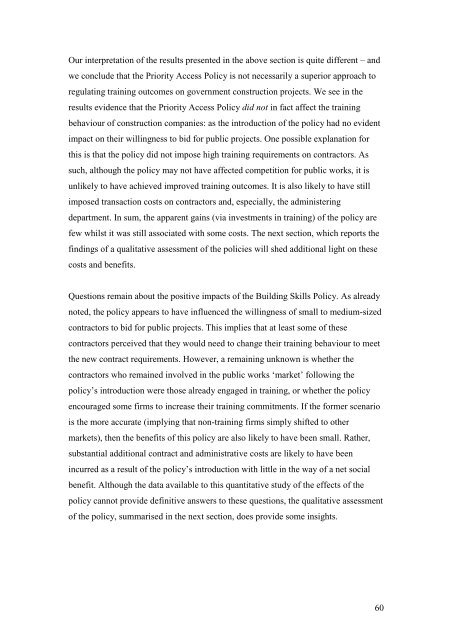Multi Outcome Construction Policy (final report)
Multi Outcome Construction Policy (final report)
Multi Outcome Construction Policy (final report)
You also want an ePaper? Increase the reach of your titles
YUMPU automatically turns print PDFs into web optimized ePapers that Google loves.
Our interpretation of the results presented in the above section is quite different – andwe conclude that the Priority Access <strong>Policy</strong> is not necessarily a superior approach toregulating training outcomes on government construction projects. We see in theresults evidence that the Priority Access <strong>Policy</strong> did not in fact affect the trainingbehaviour of construction companies: as the introduction of the policy had no evidentimpact on their willingness to bid for public projects. One possible explanation forthis is that the policy did not impose high training requirements on contractors. Assuch, although the policy may not have affected competition for public works, it isunlikely to have achieved improved training outcomes. It is also likely to have stillimposed transaction costs on contractors and, especially, the administeringdepartment. In sum, the apparent gains (via investments in training) of the policy arefew whilst it was still associated with some costs. The next section, which <strong>report</strong>s thefindings of a qualitative assessment of the policies will shed additional light on thesecosts and benefits.Questions remain about the positive impacts of the Building Skills <strong>Policy</strong>. As alreadynoted, the policy appears to have influenced the willingness of small to medium-sizedcontractors to bid for public projects. This implies that at least some of thesecontractors perceived that they would need to change their training behaviour to meetthe new contract requirements. However, a remaining unknown is whether thecontractors who remained involved in the public works ‘market’ following thepolicy’s introduction were those already engaged in training, or whether the policyencouraged some firms to increase their training commitments. If the former scenariois the more accurate (implying that non-training firms simply shifted to othermarkets), then the benefits of this policy are also likely to have been small. Rather,substantial additional contract and administrative costs are likely to have beenincurred as a result of the policy’s introduction with little in the way of a net socialbenefit. Although the data available to this quantitative study of the effects of thepolicy cannot provide definitive answers to these questions, the qualitative assessmentof the policy, summarised in the next section, does provide some insights.60
















